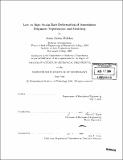| dc.contributor.advisor | Mary C. Boyce. | en_US |
| dc.contributor.author | Mulliken, Adam Dustin, 1979- | en_US |
| dc.contributor.other | Massachusetts Institute of Technology. Dept. of Mechanical Engineering. | en_US |
| dc.date.accessioned | 2005-09-27T17:22:05Z | |
| dc.date.available | 2005-09-27T17:22:05Z | |
| dc.date.copyright | 2004 | en_US |
| dc.date.issued | 2004 | en_US |
| dc.identifier.uri | http://hdl.handle.net/1721.1/28622 | |
| dc.description | Thesis (S.M.)--Massachusetts Institute of Technology, Dept. of Mechanical Engineering, 2004. | en_US |
| dc.description | Includes bibliographical references (p. 209-212). | en_US |
| dc.description.abstract | A combined experimental and analytical investigation has been performed to understand the mechanical behavior of two amorphous polymers--polycarbonate and poly(methvl methacrylate)--at strain rates ranging from 10⁻⁴ to 10⁴ s⁻¹. This spectrum of strain rates was achieved in tension/compression tests using a dynamic mechanical analyzer (DMA), a servo-hydraulic testing machine and a split-Hopkinson pressure bar. Tension tests on the DMA were used to characterize the time-temperature dependence of the elastic storage moduli and the loss factors of the two polymers. The DMA data provided a quantification of the rate-dependent shift of material transitions, and led to an analytical description of the elastic moduli at all rates and temperatures. Uniaxial compression tests were performed at strain rates of 10⁻⁴ s⁻¹ to 1 s⁻¹ using a servo-hydraulic testing machine. Stress-strain behavior of the materials was found to be rate-dependent in this regime, with yield strength increasing in a linear and non-linear fashion for PC and PMMA, respectively, with the logarithm of strain rate. High strain rate tests were performed using an aluminum split-Hopkinson pressure bar system. Material strengthening as a function of strain rate was observed to be dramatically greater in this high-rate regime for both materials. A physically-based constitutive model for large strain deformation of thermoplastics, which has been shown to be accurate at quasi-static rates of deformation, was then extended to encompass very high rate conditions. The revised model uses the viscoelastic material transitions quantified in DMA testing, as well an understanding of the molecular mechanisms of resistance to deformation at high rates, to capture the overall transition of the | en_US |
| dc.description.abstract | (cont.) stress-strain behavior to a regime of increased rate-dependence of yield. The model is shown to be predictive of the behavior of these materials over a wide spectrum of strain rates. | en_US |
| dc.description.statementofresponsibility | by Adam Dustin Mulliken. | en_US |
| dc.format.extent | 212 p. | en_US |
| dc.format.extent | 9125498 bytes | |
| dc.format.extent | 9155385 bytes | |
| dc.format.mimetype | application/pdf | |
| dc.format.mimetype | application/pdf | |
| dc.language.iso | en_US | |
| dc.publisher | Massachusetts Institute of Technology | en_US |
| dc.rights | M.I.T. theses are protected by copyright. They may be viewed from this source for any purpose, but reproduction or distribution in any format is prohibited without written permission. See provided URL for inquiries about permission. | en_US |
| dc.rights.uri | http://dspace.mit.edu/handle/1721.1/7582 | |
| dc.subject | Mechanical Engineering. | en_US |
| dc.title | Low to high strain rate deformation of amorphous polymers : experiments and modeling | en_US |
| dc.type | Thesis | en_US |
| dc.description.degree | S.M. | en_US |
| dc.contributor.department | Massachusetts Institute of Technology. Department of Mechanical Engineering | |
| dc.identifier.oclc | 57562459 | en_US |
